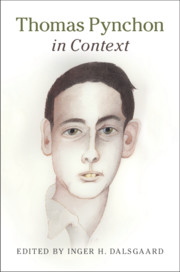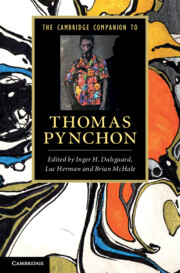20 results
Part I - Times and Places
-
- Book:
- Thomas Pynchon in Context
- Published online:
- 31 May 2019
- Print publication:
- 20 June 2019, pp 5-112
-
- Chapter
- Export citation
Chapter 20 - Real Estate and the Internet
- from Part II - Culture, Politics, and Society
-
-
- Book:
- Thomas Pynchon in Context
- Published online:
- 31 May 2019
- Print publication:
- 20 June 2019, pp 162-171
-
- Chapter
- Export citation
Contributors
-
- Book:
- Thomas Pynchon in Context
- Published online:
- 31 May 2019
- Print publication:
- 20 June 2019, pp ix-xvii
-
- Chapter
- Export citation
Abbreviations
-
- Book:
- Thomas Pynchon in Context
- Published online:
- 31 May 2019
- Print publication:
- 20 June 2019, pp xviii-xviii
-
- Chapter
- Export citation
Part II - Culture, Politics, and Society
-
- Book:
- Thomas Pynchon in Context
- Published online:
- 31 May 2019
- Print publication:
- 20 June 2019, pp 113-270
-
- Chapter
- Export citation
Introduction
-
-
- Book:
- Thomas Pynchon in Context
- Published online:
- 31 May 2019
- Print publication:
- 20 June 2019, pp 1-4
-
- Chapter
- Export citation
Index
-
- Book:
- Thomas Pynchon in Context
- Published online:
- 31 May 2019
- Print publication:
- 20 June 2019, pp 381-390
-
- Chapter
- Export citation
Copyright page
-
- Book:
- Thomas Pynchon in Context
- Published online:
- 31 May 2019
- Print publication:
- 20 June 2019, pp iv-iv
-
- Chapter
- Export citation
Further Reading
-
- Book:
- Thomas Pynchon in Context
- Published online:
- 31 May 2019
- Print publication:
- 20 June 2019, pp 361-380
-
- Chapter
- Export citation
Contents
-
- Book:
- Thomas Pynchon in Context
- Published online:
- 31 May 2019
- Print publication:
- 20 June 2019, pp v-viii
-
- Chapter
- Export citation
Part III - Approaches and Readings
-
- Book:
- Thomas Pynchon in Context
- Published online:
- 31 May 2019
- Print publication:
- 20 June 2019, pp 271-360
-
- Chapter
- Export citation

Thomas Pynchon in Context
-
- Published online:
- 31 May 2019
- Print publication:
- 20 June 2019
Other titles in this series
-
- Book:
- The Cambridge Companion to Thomas Pynchon
- Published online:
- 28 March 2012
- Print publication:
- 15 December 2011, pp 195-200
-
- Chapter
- Export citation
Frontmatter
-
- Book:
- The Cambridge Companion to Thomas Pynchon
- Published online:
- 28 March 2012
- Print publication:
- 15 December 2011, pp i-xii
-
- Chapter
- Export citation
PART II - POETICS
-
- Book:
- The Cambridge Companion to Thomas Pynchon
- Published online:
- 28 March 2012
- Print publication:
- 15 December 2011, pp -
-
- Chapter
- Export citation
Index
-
- Book:
- The Cambridge Companion to Thomas Pynchon
- Published online:
- 28 March 2012
- Print publication:
- 15 December 2011, pp 201-193
-
- Chapter
- Export citation
Selected Bibliography
-
- Book:
- The Cambridge Companion to Thomas Pynchon
- Published online:
- 28 March 2012
- Print publication:
- 15 December 2011, pp 178-186
-
- Chapter
- Export citation
PART III - ISSUES
-
- Book:
- The Cambridge Companion to Thomas Pynchon
- Published online:
- 28 March 2012
- Print publication:
- 15 December 2011, pp -
-
- Chapter
- Export citation
PART I - CANON
-
- Book:
- The Cambridge Companion to Thomas Pynchon
- Published online:
- 28 March 2012
- Print publication:
- 15 December 2011, pp -
-
- Chapter
- Export citation

The Cambridge Companion to Thomas Pynchon
-
- Published online:
- 28 March 2012
- Print publication:
- 15 December 2011

